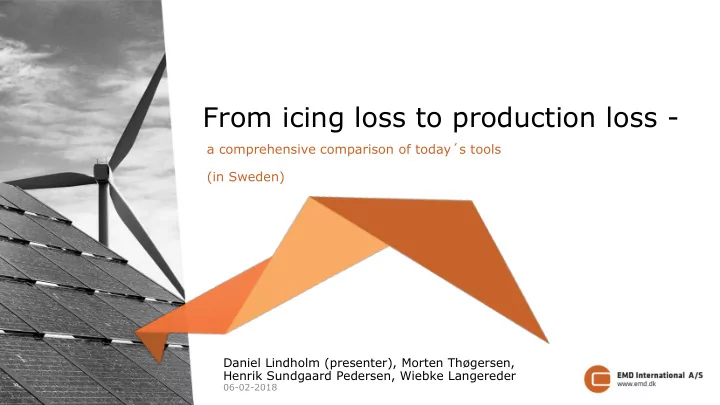

From icing loss to production loss - a comprehensive comparison of today´s tools (in Sweden) Daniel Lindholm (presenter), Morten Thøgersen, Henrik Sundgaard Pedersen, Wiebke Langereder 06-02-2018
Background Purpose of presentation Most presentations focus on this: • Today, Im going to talk about this: 06-02-2018 2
Limitations Goal of the Presentation Compare the different methods on the same location • Create a basis for expected differences and • uncertainties in pre construction situations 06-02-2018 3
Available methods In this presentation the following methods were observed: IEA icing classification • “Fiddle factor” estimate • Kjeller Vindteknikks icing map • DNV/GL Ice map. • WIceAtlas map • 06-02-2018 4
Model description IEA icing classification Presents icing in five • different classes Challenges Overlapping Classes • and “unusable” range of expected losses 06-02-2018 5
Model description “Fiddle factor” Uses a factor on the observed icing to • present icing loss Examples have been seen varying from • 0,25-0,5 Challenges Result highly dependent on the factor • chosen “Based on experience” is a rather vague • argument 06-02-2018 6
Model description Kjeller Vindteknikks icing map Presents icing as number of icing • hours per year which is converted to production loss. Challenges Low Resolution and inability to • capture local “ coldspots ” Estimates presented in a range • 06-02-2018 7
Model description DNV/GL map Presents icing as a fixed • number, based on production data and the relationship between hub height elevation and ice loss Challenges Questions related to the • second trend (not implemented in the current ice map) 06-02-2018 8
Model description WIceAtlas map (honorable mention) Presents results as different • IEA ice classes Challenges Hard (as in not really • possible) to convert to a single value 06-02-2018 9
Methodology Assumptions and methodology Flagging system based on difference in ΔV between fully heated and shaft heated • anemometer as well as instrumental stand-still during icing season Period assumed to start 30 minutes before and after each flagged period • Only one winter season is taken into account • Multiple winters are split and treated separately • Mean value from Kjeller Vindteknikk map ranges used • No consideration taken in regards to proximity to nearby areas (KVT) • Single value obtained from the IEA relationship between instrumental icing and • production loss “Fiddle factor” of 0,4 used for presentation • All instrumental icing Long term corrected with seasonal Icing index • Only masts between 85-100m used for evaluation • Only Thies first class shaft heated anemometers used for evaluation • 06-02-2018 10
Results Examples of Inter annual difference in instrumental icing Before seasonal index correction After seasonal index correction 12 12 10 10 Instrumental icing % Instrumental icing % 2008 2008 8 8 2009 2009 2010 2010 6 6 2011 2011 4 4 2012 2012 2013 2013 2 2 0 0 Mast 1 Mast 2 Mast 3 Mast 4 Mast5 Mast 1 Mast 2 Mast 3 Mast 4 Mast5 06-02-2018 11
Results Difference of expected long term production loss Resulting production loss estimates for the four models for 10 sites and 16 different seasons 12 10 Production loss % 8 6 4 2 0 Mast Name 1A 1B 2 3A 3B 3C 4A 4B 5A 5B 6 7 8 9 10 FF 0,4 KVT IEA DNV/GL ICE 06-02-2018 12
Results Difference of expected long term production loss Absolute difference to the mean of the four models 5 4 % Production loss difference 3 2 1 0 0 2 4 6 8 10 12 14 16 -1 -2 -3 -4 FF 0,4 KVT IEA DNV/GL ICE 06-02-2018 13
Wrap-up What can be learned Some spread can be observed (and was expected), • but given the strict input procedure, the results are looking promising Using a mean value of all methods is a possible • approach Having one year of measurement as a basis for a icing • loss evaluation increases uncertainty due to inter annual variability 06-02-2018 14
Thank you for listening! Och håll ut! 06-02-2018 15
Recommend
More recommend